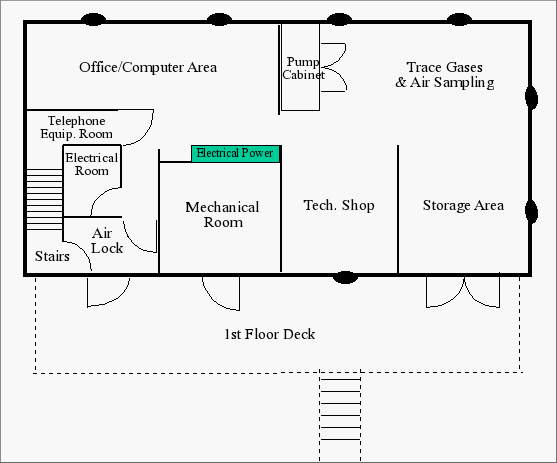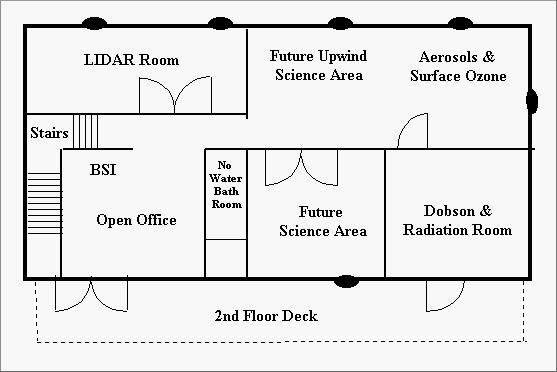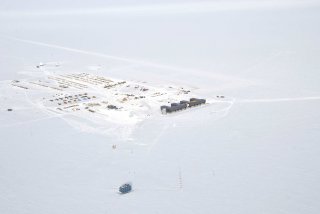
The Atmospheric Research Observatory (ARO) at the Amundsen-Scott South Pole Station is a National Science Foundation (NSF) facility located near the geographic South Pole. The NSF has allocated ARO to a long-term research program conducted by the National Oceanic and Atmospheric Administration's Global Monitoring Laboratory (NOAA/OAR/GML).
ARO is located approximately four hundred meters grid east-northeast of the main station, physically separated and on the edge of a designated area called the Clean Air Sector. Due to local meteorology, winds at South Pole are very consistent, hence the designation of the Clean Air Sector. By positioning on the edge of this sector, ARO remains upwind of the local pollution inherent around the daily industrial operations of Amundsen-Scott Station. This clean upwind air is representative of the true mixed background atmosphere over Antarctica, and by sampling this air, ARO can establish an accurate long-term climate record of the continent. The mission of ARO is to measure long-term trends of important trace gases, aerosols, and solar radiation and to investigate the influence of these gases and aerosols on the Earth's climate.
History of NOAA at the South Pole
The United States has occupied the geographic South Pole continuously since November 1956. During the first winter-over year of 1957, the first data that would become part of NOAA’s South Pole continuous record was collected (see South Pole CO2 record). While NOAA’s first dedicated employee, Vern Rumble, wintered over in 1971-72 it wasn’t until the summer of 1976-77 that the first permanent NOAA observatory was built; it was christened the “Clean Air Facility” or CAF. The CAF lasted for 20 years before the current building, the Atmospheric Research Observatory (ARO), was built in 1997. Now over 20 years old itself, the ARO is expected to last many more years (with proper maintenance).
Other Science at South Pole
ARO is home to multiple cooperative projects all operated by NOAA staff, including:
- NASA (Goddard Space Flight Center), MPLNET LiDAR, measuring aerosols and cloud structure
- NASA (Goddard Space Flight Center), AERONET CIMEL, measuring aerosol optical depth
- Environment Canada, Brewer Spectrophotometer, measuring column ozone
- SCRIPPS Institute of Oceanography, O2/N2 air sampling
- SCRIPPS Institute of Oceanography, CO2 air sampling
- CSIRO, air sampling
ARO's multipurpose science room is currently in use by Dr. Mark Conde, University of Alaska - Fairbanks. Dr. Conde has installed a ~1 mil USD doppler imager and is measuring shifts in aurora for thermospheric weather forecasting pertinent to low earth orbit satellites. This imager is operated by NSF research assistants.
About the Building
The 280 square meter (3000 sqft) ARO building is modular in construction with six-inch insulation and 15 insulated bubble windows. The building design includes rooftop hatches and five hatch windows for Dobson measurements. The ARO has two sets of cargo bay doors, one on each floor, and an outdoor crane system for hauling equipment from the ground level to the second floor. While most buildings at South Pole are heated with diesel generators, ARO is heated electrically to avoid pollution in the clean air samples.
Currently ARO, like the other outlying science buildings, has no running water or sewage system.
Clean Air Sector
Upwind of ARO lies the Clear Air Sector, or region of dominant wind direction between grid 340 and 110. Clean air sector winds are generally between 6 to 10 knots but occasionally are In the 30 knots range. Warmer temperatures are recorded near the surface at the ARO during periods of increased wind speed due to warmer air mixing down through the near-surface temperature inversion. But, wind-chill is the great equalizer on the polar plateau, with wind chills of -100°F to -140°F not uncommon.
Access to the Clean Air Sector by vehicles and even foot is strictly limited to preserve the integrity of the site. Aircraft flight paths traversing the sector are discouraged. A 100 meter vehicle exclusion zone exists downwind and surrounding the building outside of the Clean Air Sector.
First Floor
Click on one of the rooms to view a photo of that room.

Second Floor
Click on one of the rooms to view a photo of that room.



.jpg)